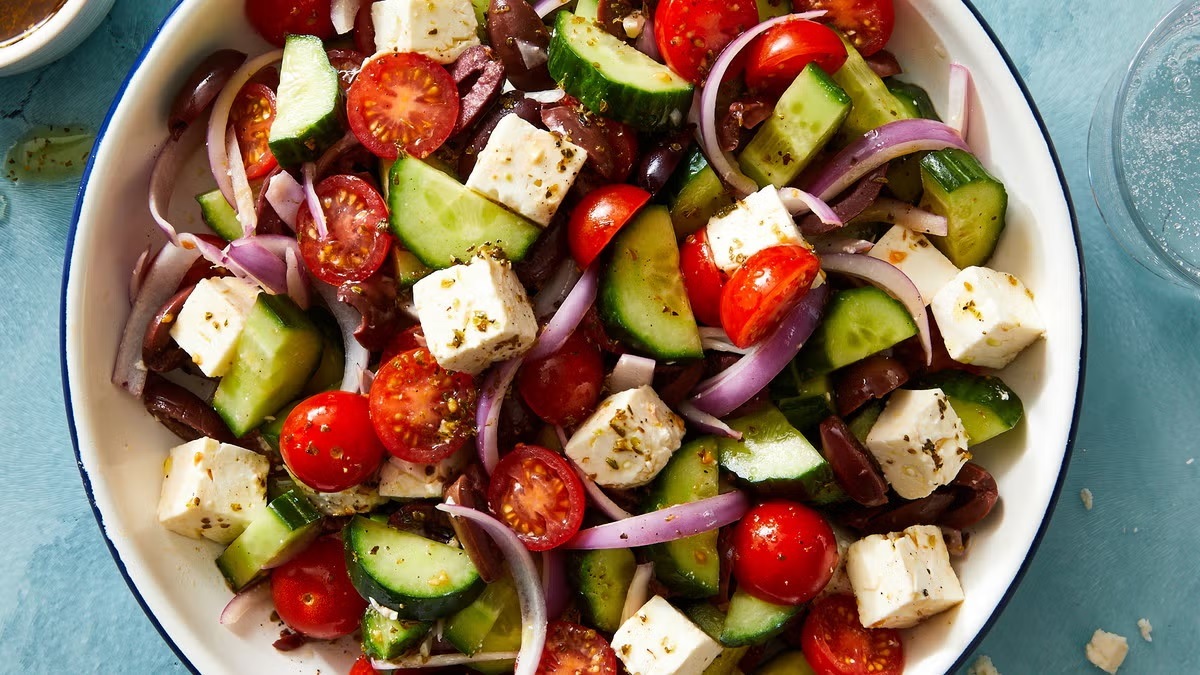This refreshing Greek salad is a perfect blend of fresh vegetables, tangy feta cheese, and briny kalamata olives. It's a simple yet flavorful dish that can be served as a side or a light main course. The combination of crisp cucumbers, juicy tomatoes, and the zesty dressing makes it an ideal choice for a healthy and delicious meal.
When preparing this Greek salad, you might need to visit the supermarket for a few specific ingredients. Kalamata olives are a key component, known for their rich, fruity flavor. Feta cheese is another essential ingredient, providing a tangy and creamy texture. Ensure you get red wine vinegar for the dressing, as it adds a distinct sharpness that complements the other flavors.

Ingredients For Greek Salad Recipe
Tomatoes: Fresh and juicy, they form the base of the salad.
Cucumber: Adds a refreshing crunch to the mix.
Red onion: Provides a sharp and tangy flavor.
Kalamata olives: Briny and rich, they enhance the salad's depth.
Feta cheese: Crumbled for a creamy and tangy touch.
Olive oil: Used in the dressing for a smooth and rich flavor.
Red wine vinegar: Adds a sharp and tangy note to the dressing.
Dried oregano: Brings an earthy and aromatic flavor.
Salt: Enhances the overall taste of the salad.
Pepper: Adds a hint of spice and depth.
Technique Tip for This Recipe
To enhance the flavor of your Greek salad, try marinating the red onion slices in a bit of red wine vinegar for about 10 minutes before adding them to the salad. This will mellow out the sharpness of the onion and add an extra layer of tanginess to the dish.
Suggested Side Dishes
Alternative Ingredients
chopped tomatoes - Substitute with cherry tomatoes: Cherry tomatoes offer a similar sweetness and juiciness, and their smaller size can add a different texture to the salad.
cucumber - Substitute with zucchini: Zucchini has a similar crunch and mild flavor, making it a good alternative to cucumber.
red onion - Substitute with shallots: Shallots provide a milder onion flavor and can be a good substitute if you prefer a less pungent taste.
kalamata olives - Substitute with black olives: Black olives have a similar texture and slightly milder flavor, making them a suitable replacement.
feta cheese - Substitute with goat cheese: Goat cheese has a similar tangy flavor and crumbly texture, making it a good alternative to feta.
olive oil - Substitute with avocado oil: Avocado oil has a similar healthy fat profile and mild flavor, making it a good substitute for olive oil.
red wine vinegar - Substitute with apple cider vinegar: Apple cider vinegar has a similar acidity and can provide a slightly different but complementary flavor.
dried oregano - Substitute with dried thyme: Dried thyme offers a similar earthy flavor and can be used as a substitute for oregano.
salt - Substitute with sea salt: Sea salt has a similar salty taste but can add a slightly different texture and mineral content.
pepper - Substitute with white pepper: White pepper provides a similar spiciness but with a slightly different flavor profile that can add a unique twist to the salad.
Other Alternative Recipes Similar to This Salad
How to Store / Freeze This Salad
- To keep your Greek salad fresh, store it in an airtight container. This will help maintain the crispness of the vegetables and the flavor of the feta cheese.
- Place the container in the refrigerator. The salad will stay fresh for up to 2-3 days. However, for the best taste and texture, it's recommended to consume it within 24 hours.
- If you anticipate leftovers, consider storing the dressing separately. This prevents the tomatoes and cucumbers from becoming soggy. Simply add the dressing just before serving.
- For an extra burst of freshness, add a few more crumbles of feta cheese and a sprinkle of oregano right before serving the leftovers.
- Freezing Greek salad is not recommended. The vegetables and feta cheese do not freeze well and will lose their texture and flavor upon thawing.
- If you must freeze, consider freezing only the dressing. Pour it into an ice cube tray, freeze, and then transfer the cubes to a freezer bag. This way, you can thaw just the amount you need for future salads.
- When ready to use the frozen dressing, thaw it in the refrigerator overnight. Give it a good whisk before adding it to your freshly chopped vegetables.
- Always check the salad for any signs of spoilage before consuming, such as an off smell or slimy texture, especially if stored for more than a day.
How to Reheat Leftovers
- If you must reheat the Greek salad, consider separating the feta cheese and olives first. These ingredients are best enjoyed cold and can be added back after reheating.
- Place the tomatoes, cucumber, and red onion mixture in a microwave-safe dish. Heat on medium power for 30-second intervals, stirring in between, until just warm. Avoid overheating to prevent the vegetables from becoming mushy.
- Alternatively, you can reheat the salad in a skillet over medium-low heat. Add a splash of olive oil to the pan and gently warm the vegetables, stirring occasionally. This method helps retain some of the salad's original texture.
- Once the vegetables are warmed, combine them back with the feta cheese and olives. Drizzle with a bit more olive oil and red wine vinegar if needed to refresh the flavors.
- For a unique twist, consider turning your leftover Greek salad into a warm pita filling. Heat the vegetables as described above, then stuff them into a pita bread along with the feta cheese and olives. Enjoy a delightful warm Greek pita sandwich.
Best Tools for Making This Salad
Large mixing bowl: Use this to combine the tomatoes, cucumber, red onion, olives, and feta cheese.
Small bowl: Perfect for whisking together the olive oil, red wine vinegar, and oregano to make the dressing.
Whisk: Essential for thoroughly mixing the dressing ingredients to ensure they are well combined.
Chef's knife: Ideal for chopping the tomatoes, slicing the cucumber, and thinly slicing the red onion.
Cutting board: Provides a stable surface for chopping and slicing the vegetables.
Measuring cups: Useful for accurately measuring out the tomatoes, cucumber, olives, and feta cheese.
Measuring spoons: Necessary for measuring the olive oil, red wine vinegar, and oregano.
Serving spoon: Handy for tossing the salad and serving it once it's ready.
Salad tongs: Great for mixing the salad ingredients together and serving the salad.
How to Save Time on Making This Salad
Pre-chop vegetables: Prepare the tomatoes, cucumber, and red onion in advance and store them in airtight containers in the fridge.
Use pre-pitted olives: Save time by buying kalamata olives that are already pitted.
Buy crumbled feta: Purchase feta cheese that is already crumbled to avoid extra prep work.
Make dressing in bulk: Whisk together a larger batch of olive oil, red wine vinegar, and oregano and store it in the fridge for future use.
Use a mandoline slicer: Quickly slice the cucumber and red onion with a mandoline slicer for uniform pieces.

Greek Salad Recipe
Ingredients
Main Ingredients
- 2 cups chopped tomatoes
- 1 cup cucumber, sliced
- ½ cup red onion, thinly sliced
- 1 cup kalamata olives
- 1 cup feta cheese, crumbled
- 2 tablespoon olive oil
- 1 tablespoon red wine vinegar
- 1 teaspoon dried oregano
- to taste salt and pepper
Instructions
- In a large mixing bowl, combine tomatoes, cucumber, red onion, olives, and feta cheese.
- In a small bowl, whisk together olive oil, red wine vinegar, and oregano.
- Pour the dressing over the salad and toss to combine.
- Season with salt and pepper to taste. Serve immediately.
Nutritional Value
Keywords
More Amazing Recipes to Try 🙂
- Strawberry Cake Recipe50 Minutes
- Roasted Pork Chops Recipe30 Minutes
- Vietnamese Iced Coffee Recipe10 Minutes
- Ricotta Cheese Recipe40 Minutes
- Fried Rice with Ham Recipe25 Minutes
- Breakfast Sausage Recipe25 Minutes
- Beef Stir Fry Recipe25 Minutes
- Feijoada Brazilian Black Bean Stew Recipe2 Hours 30 Minutes


Leave a Reply